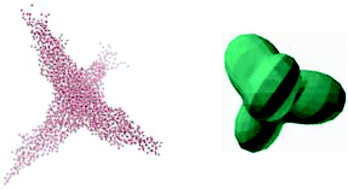当前位置:
X-MOL 学术
›
Soft Matter
›
论文详情
Our official English website, www.x-mol.net, welcomes your
feedback! (Note: you will need to create a separate account there.)
When droplets become stars: charged dielectric droplets beyond the Rayleigh limit
Soft Matter ( IF 2.9 ) Pub Date : 2017-11-09 00:00:00 , DOI: 10.1039/c7sm02017a Myong In Oh 1, 2, 3, 4 , Anatoly Malevanets 5, 6, 7, 8 , Maxim Paliy 1, 2, 3, 4 , Daan Frenkel 1, 8, 9, 10 , Styliani Consta 1, 1, 2, 3, 4
Soft Matter ( IF 2.9 ) Pub Date : 2017-11-09 00:00:00 , DOI: 10.1039/c7sm02017a Myong In Oh 1, 2, 3, 4 , Anatoly Malevanets 5, 6, 7, 8 , Maxim Paliy 1, 2, 3, 4 , Daan Frenkel 1, 8, 9, 10 , Styliani Consta 1, 1, 2, 3, 4
Affiliation

|
When a nano-drop comprising a single spherical central ion and dielectric solvent is charged above a well-defined threshold, it acquires a stable star morphology. In contrast, conducting droplets, will undergo fission. Here we report combined atomistic molecular dynamics and continuum modelling study of star formation of droplets that contain a highly charged ion. We assume that in the continuum model the dielectric response is linear. In this linear continuum model, which is an extension of Rayleigh model, the energy of the drop is comprised of terms analogous to those in Rayleigh model, which are surface energy and electrostatic energy of dielectric droplet charged by a central point charge. We present the stability analysis of the continuum model to determine the threshold of instability. Indeed we find that the model accounts well for the onset of the instabilities. Molecular dynamics show that the number of points of the star-shaped nano-drops depends only on the surface tension, dielectric constant and size of the droplet, and on the magnitude of the charge of the central ion, but not on its sign. Intuitively, it is expected that when a spherical dielectric drop becomes unstable it would transform into a non-spherical finite shape of the same volume as the initial spherical shape with the point charge located in the drop interior. To test whether the extended Rayleigh model can account for the observed droplet shapes, we performed numerical simulations of the linear continuum model. Contrary to the expectations, the simulations of the extended Rayleigh model does not reproduce the stable star shapes found in the atomistic simulations, not even when we account for the bending rigidity and spontaneous curvature of the surface. We argue that the assumption that the dielectric response is linear breaks down if the droplet surface approaches the central macro-ion, where the electric field strength is such that dielectric saturation sets in. We envisage that for certain solvents, these stars could be made permanent by cross-linking, opening the way to the production of a novel class of highly-non-convex colloids.
中文翻译:

当液滴变成恒星时:带电的绝缘液滴超过瑞利极限
当包含单个球形中心离子和介电溶剂的纳米滴的电荷超过明确定义的阈值时,它将获得稳定的星形形态。相反,导电液滴将发生裂变。在这里,我们报告结合原子分子动力学和包含高电荷离子的液滴的恒星形成的连续谱模型研究。我们假设在连续模型中介电响应是线性的。在作为Rayleigh模型的扩展的线性连续体模型中,液滴的能量由类似于Rayleigh模型的项组成,这些项是由中心点电荷充电的介电液滴的表面能和静电能。我们提出连续性模型的稳定性分析,以确定不稳定性的阈值。实际上,我们发现该模型很好地说明了不稳定性的发生。分子动力学表明,星形纳米液滴的点数仅取决于表面张力,介电常数和液滴大小,并取决于中心离子的电荷大小,而不取决于其符号。凭直觉,可以预期的是,当球形介电液滴变得不稳定时,它将转变为与初始球形体积相同的非球形有限形状,并且点电荷位于液滴内部。为了测试扩展的瑞利模型是否可以解释观察到的液滴形状,我们对线性连续模型进行了数值模拟。与期望相反,即使我们考虑了表面的弯曲刚度和自发曲率,扩展瑞利模型的仿真也无法重现在原子仿真中发现的稳定的星形。我们认为,如果液滴表面接近中心宏离子,则介电响应为线性的假设将被打破,在该中心宏离子中电场强度足以使介电饱和度进入。我们设想对于某些溶剂,这些恒星可以被永久化通过交联,开辟了生产新型非凸型胶体的道路。
更新日期:2017-11-15
中文翻译:

当液滴变成恒星时:带电的绝缘液滴超过瑞利极限
当包含单个球形中心离子和介电溶剂的纳米滴的电荷超过明确定义的阈值时,它将获得稳定的星形形态。相反,导电液滴将发生裂变。在这里,我们报告结合原子分子动力学和包含高电荷离子的液滴的恒星形成的连续谱模型研究。我们假设在连续模型中介电响应是线性的。在作为Rayleigh模型的扩展的线性连续体模型中,液滴的能量由类似于Rayleigh模型的项组成,这些项是由中心点电荷充电的介电液滴的表面能和静电能。我们提出连续性模型的稳定性分析,以确定不稳定性的阈值。实际上,我们发现该模型很好地说明了不稳定性的发生。分子动力学表明,星形纳米液滴的点数仅取决于表面张力,介电常数和液滴大小,并取决于中心离子的电荷大小,而不取决于其符号。凭直觉,可以预期的是,当球形介电液滴变得不稳定时,它将转变为与初始球形体积相同的非球形有限形状,并且点电荷位于液滴内部。为了测试扩展的瑞利模型是否可以解释观察到的液滴形状,我们对线性连续模型进行了数值模拟。与期望相反,即使我们考虑了表面的弯曲刚度和自发曲率,扩展瑞利模型的仿真也无法重现在原子仿真中发现的稳定的星形。我们认为,如果液滴表面接近中心宏离子,则介电响应为线性的假设将被打破,在该中心宏离子中电场强度足以使介电饱和度进入。我们设想对于某些溶剂,这些恒星可以被永久化通过交联,开辟了生产新型非凸型胶体的道路。











































 京公网安备 11010802027423号
京公网安备 11010802027423号